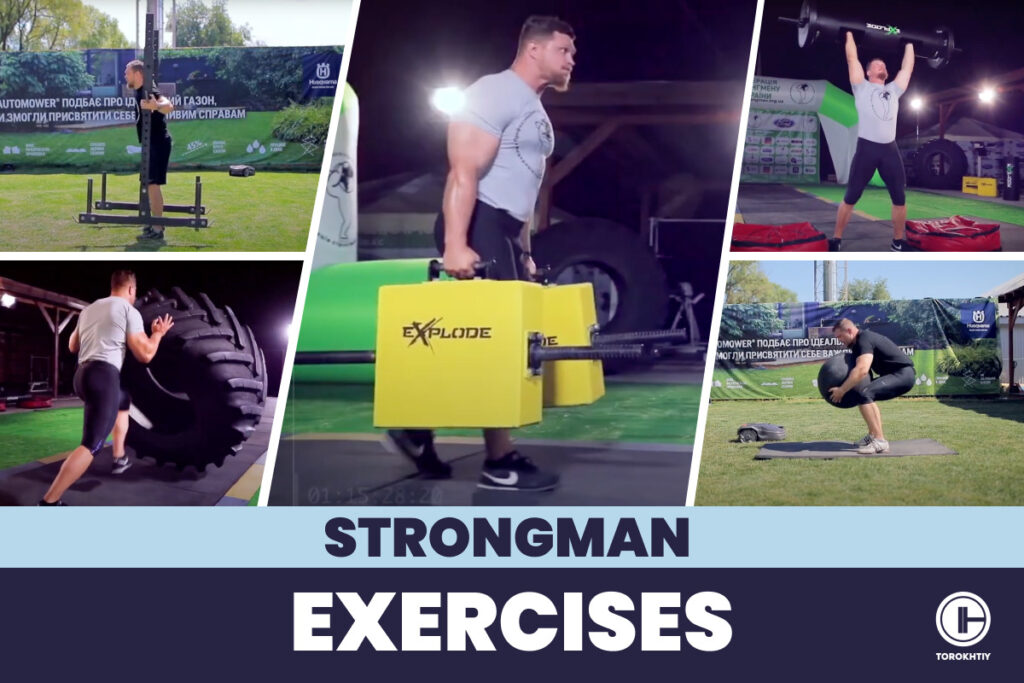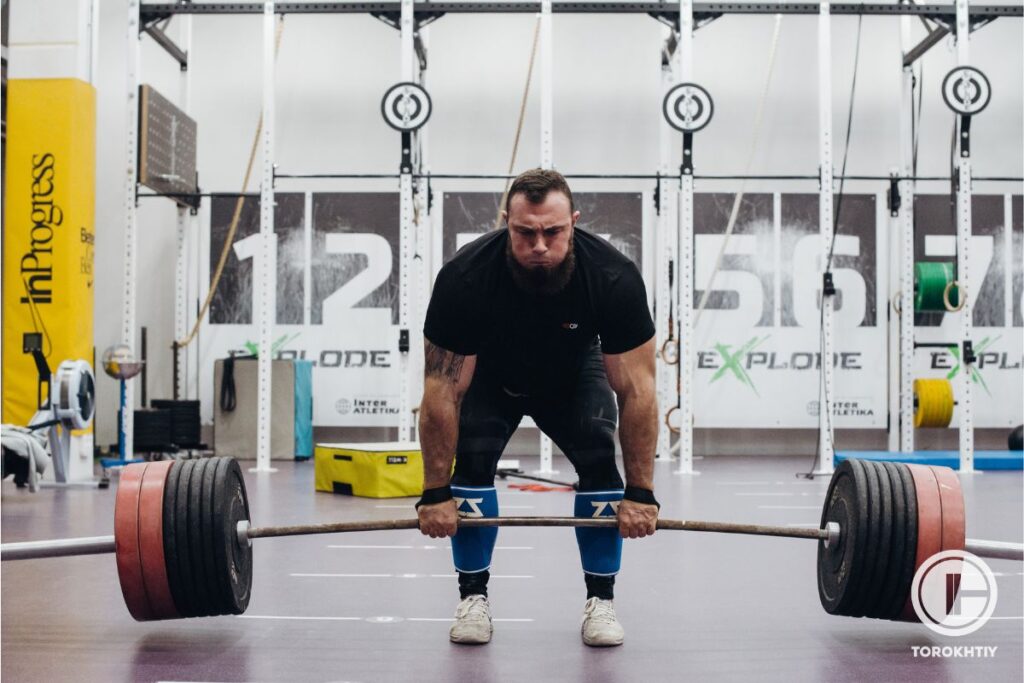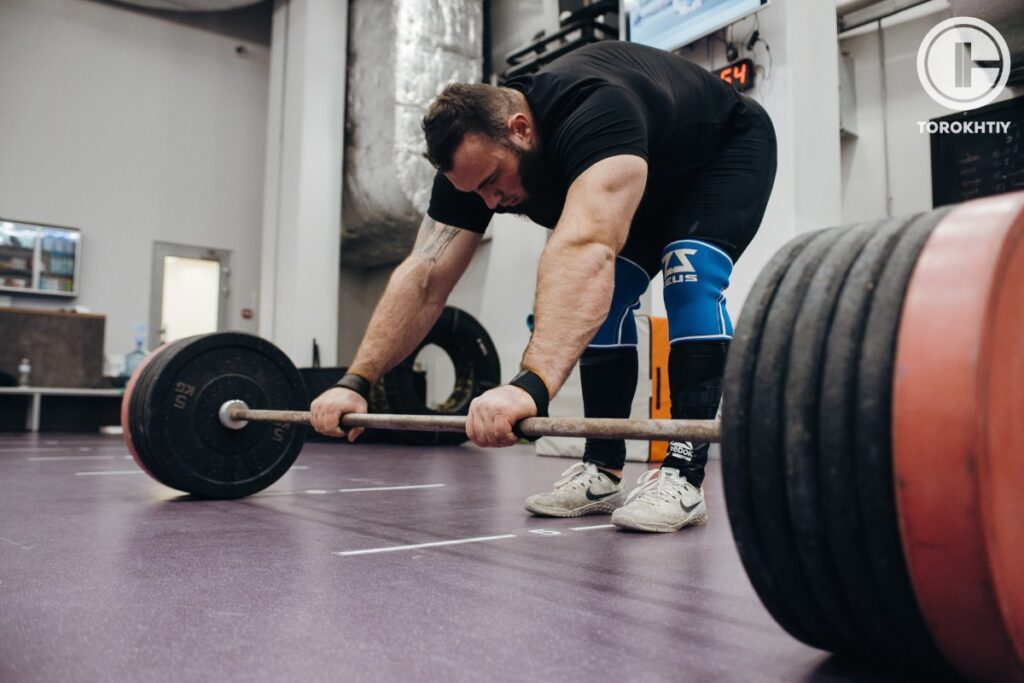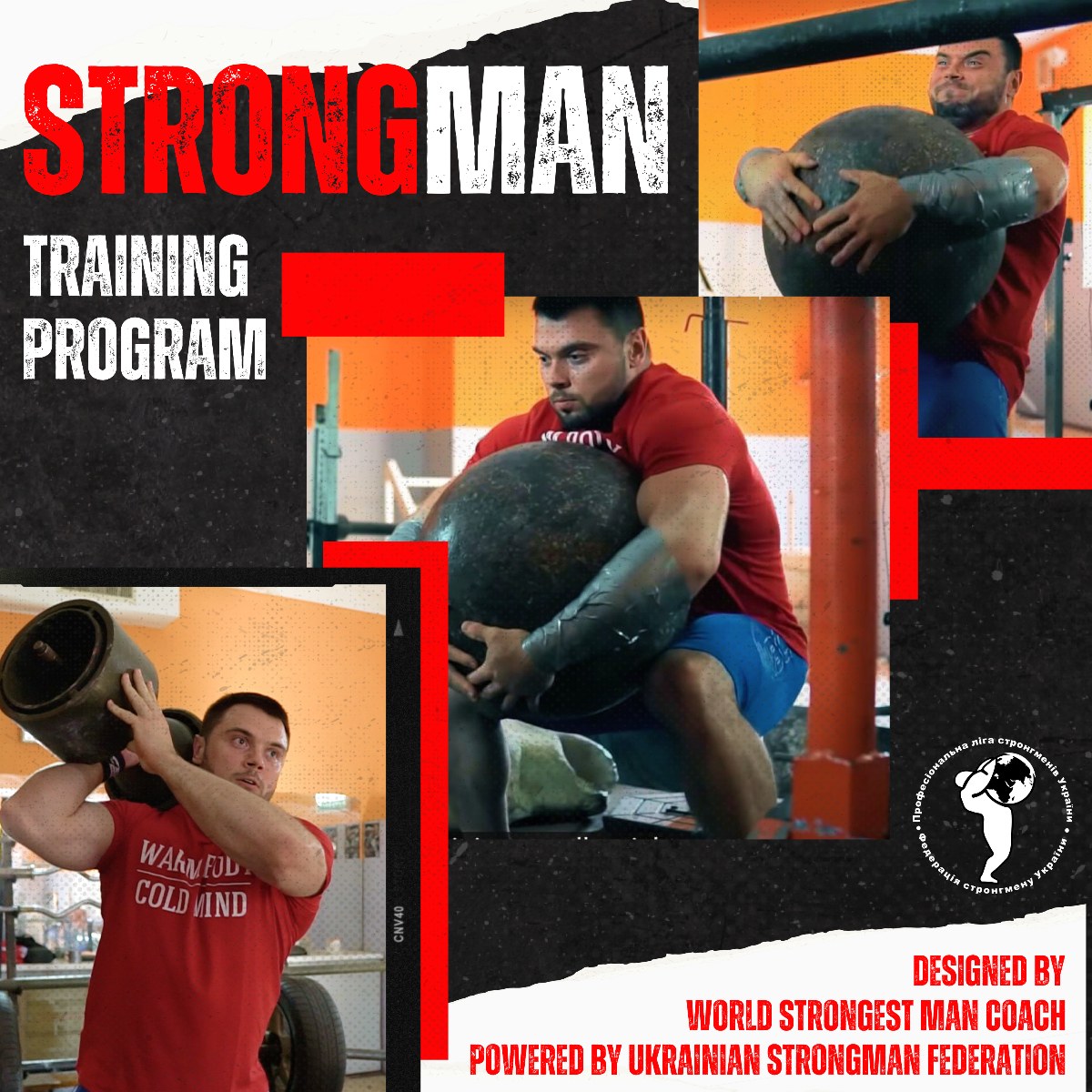12 Strongman Exercises to Build Strength (+Workout Example)
Author:
Reviewed by:
(21 years of Oly Lifting experience)
Unlock your full potential by engaging with our experts and community! Have questions about your fitness journey or looking for expert advice on weightlifting techniques? Don’t hesitate — leave a comment below and Sergiy Osipchyk will provide a personalized answer and insights to help you reach your goals.
Torokhtiy is reader-supported. Some links are affiliate links, and we may earn a commission at no extra cost to you. See our disclosure page for details.
Why even bother with strongman exercises when conventional strength training offers a plethora of effective exercises? It’s actually simple – conventional exercises often don’t challenge your muscles in the way strongman ones do. They’re rooted in traditions of strongman competitions and they’re designed to push your limits.
The great thing about them is their versatility. You don’t need a lot of fancy equipment to get started, you can get by on just a few key pieces and willingness to work hard. Plus, strongman movements are incredibly functional and they’ll help you build actual, real-world strength that can carry over to your daily life.
We’ll get into some of the best strongman exercises you can include into your routine, like the Farmer’s Walk and Atlas Stone lift, as well as some others that aren’t as popular but that are just as effective.
Ready to work really, really hard and learn how to train like a strongman? Let’s go!
What are strongman exercises? – They are strength training workouts that mimic tasks from strongman competitions. This includes lifting heavy stones, flipping tires, carrying large objects, etc. They are excellent for building full-body strength, power, and functional fitness.

6 Competitive Strongman Exercises (Overview) + Additional Ones
You don’t know power and strength until you see a strongman competition. It’s a true test of your overall strength and power and its participants need to do a series of super demanding strongman workouts. Each event is designed in a way that challenges different muscle groups and aspects of physical fitness, which includes strength, endurance, and technique.
It sounds a little intimidating but impressive at the same time, right? Let’s get into some of the most iconic strongman exercises and explore them further.
Save it for easy access!
Bookmark this page now to access the program and instructional videos anytime, anywhere.
Stop wasting time searching during your gym sessions.
1. Running Weight Transfers on Shoulders/ Hands
To kick things off, we’ll start with one of the cornerstones of strongman competition exercises – moving heavy weights over a distance and often transitioning from one position to the other. This category of exercises is all about coordination, balance, and just plain brute strength.
• Yoke
An absolute staple, the yoke. If you decide to compete, there’s no getting around this one. It involves carrying a heavy, rectangular frame that sits on the shoulders and if you think that sounds simple enough, think again because it takes immense stability and leg strength.
The yoke consists of a central bar that rests on your shoulders and it’s connected to two vertical bars with weights attached at the bottom. Here’s how to do it:
- Place the yoke on the ground with weights attached
- Stand under the yoke and place the crossbar on your shoulders
- Adjust the height so the yoke rests comfortably
- Engage your core, take a deep breath, and extend your legs to lift the yoke and stand up straight
- Start walking and keep a steady pace without moving side-to-side too much
- Walk the distance that’s required, then carefully set the yoke down.
It’s hard to do and it will challenge your entire body, especially your legs, core, and back. But it can do wonders for your balance, coordination, and strength in general, so if you’re serious about strongman training, this is one you can’t miss out on.
Start with a weight that’s manageable because you need to perfect your technique so that you’re safe and you get results from doing it.
• Farmer’s Walk
Another staple. You’ll carry heavy weights in each hand and then you’ll walk a set distance. You’ve probably heard of this one even if you’re not into strongman training because it’s very popular.
This is how you do it:
- Grab a pair of heavy dumbbells or farmer’s walk handles
- Stand with your feet shoulder-width apart
- Make sure your back is straight and core engaged
- Extend your hips and knees and lift the weights off the ground
- Stand tall with the weights at your sides and start walking while keeping your posture upright
- Keep your pace steady and controlled
- Carefully set the weights down once you finish
Farmer’s walk will target your grip, forearms, shoulders, core, and legs. It’s an excellent way to build functional strength and improve grip endurance, which is a bigger deal than you may think when it comes to strongman competitions.
Start with weights that will challenge your grip, but not so much that it will mess up your form. If you want to work on endurance, practice walking different distances.
2. Overhead Lift Above Yourself
Strongman competitions often have feature events where people who participate lift heavy objects overhead. These exercises are supposed to test the strength of your upper body, as well as stability and technique.
• Log Lift
For this strongman lifting exercise, you lift a large, cylindrical log from the ground to overhead in one single motion. Here’s how:
- Place the log on the ground in front of you
- Stand behind the log with a wide stance
- Squat down and grip the handles inside the log
- Extend your hips and knees to lift the log to your lap
- Roll the log up to your chest to shoulder height
- Press the log overhead and lock out your arms
- Lower it back down in a controlled way
The log lift will build explosive power in your legs, back, and shoulders, and it will also improve your coordination and stability. This is very important if you want to lift successfully and be able to manage heavy weights.
Just make sure to use your legs to drive up and don’t rely only on your arms. You can practice the clean and press movements separately to work on your technique. And do we even need to mention you need to start with lighter logs until your form is perfect or does that go without saying?
• Axle Press
The axle press involves lifting a thick-bar axle from the ground to overhead. This will challenge the strength of your grip and upper body power.
Here’s how you do the axle press:
- Place the axle on the ground with weights attached
- Stand behind the axle with a mixed grip (one palm up, one palm down)
- Extend your hips and knees to lift the axle to your shoulders
- Adjust your grip to hold the axle at shoulder height
- Press the axle overhead and lock out your arms
- Lower the axle back carefully
This exercise will develop your upper body strength, grip endurance, and shoulder stability. It will also work its magic on technique and power in overhead lifts, which is important for a lot of strongman events.
Keep your grip strong and steady press, and you can even include some grip training in your routine so it’s easier to handle the thick bar. Grippers are an easy, affordable way to do that and there are tons of options to choose from.
3. Traction at Different Angles
This is basically lifting heavy weights from the ground in different ways and the exercises test different angles of pulling strength.
• Deadlift
Who hasn’t heard of the deadlift? It’s a basic strength exercise in which you lift a heavy barbell from the ground to a standing position.
You probably already know how to do a deadlift, but let’s go over it just in case.
- Stand with your feet hip-width apart with the bar over your mid-foot
- Bend at the hips and knees to grip the bar
- Engage your core, take a deep breath,and lift the bar
- Stand tall with the bar at hip height
- Lower it back down in a controlled way
The deadlift is an absolute superstar; it engages your entire posterior chain, improves posture, and it’s a crucial part of any strength training.
Keep your back straight and make sure your core is engaged throughout the entire lift.
• Silver Dollar Deadlift
This is a variation of the traditional deadlift where you load the barbell with weights at a higher starting point, often using large boxes and blocks.
You do it kind of like the regular deadlift:
- Place the barbell on elevated blocks or boxes
- Stand with your feet hip-width apart and grab the bar
- Engage your core, take a deep breath, and extend your hips and knees to lift the bar
- Stand tall with the bar at hip height, then lower it back down in a controlled way
The silver dollar deadlift focuses on the lockout portion of the deadlift and builds strength in your back, glutes, and hamstrings. It’s excellent for developing max lifting power and the elevated position will allow you to lift heavier because of the reduced range of motion.
• Stone Lift (Atlas Stones)
To do the stone lift, you lift heavy, round stones from the ground to a platform or over a bar. This mimics the traditional strongman event.
Here’s how you do it:
- Get behind the stone with a wide stance
- Squat down, wrap your arms around the stone and grip it tightly
- Extend your hips and knees at the same time to lift the stone, then place it on your lap and readjust the grip
- Stand and hoist the stone onto the platform or over the bar
- Lower the stone back to the ground carefully
If you struggle with your grip, you might want to use a tacky substance to help. You can also practice lifting smaller stones to learn the technique before lifting super heavy ones.
In addition to using tacky, you can improve your performance with grip training exercises like plate pinches, farmer’s holds, and wrist curls. Practicing the lap-to-chest transition with smaller stones or sandbags is another good way to work on your performance because it can help you become more efficient in this critical phase of the lift.
This exercise, although demanding, works fantastic for building and improving explosive power, grip strength, and full-boy coordination. It mimics real-world lifting situations, so you can expect improvements in your functional strength and endurance.
Follow us!

Free!
Get a 2-week Weightlifting Program as a bonus for the subscription to kickstart your training plan!

Free!
4. Throwing Exercises
When it comes to throwing exercises in strongman competitions, they’re all about explosive power and precision. These events will test how high or far an athlete can throw a heavy object, and if you want to be successful (or even decent at it), you’ll need a combination of strength, technique, and coordination.
• Keg Toss
This is one of the more popular strongman lifts. You throw a weighted keg over a high bar, which sounds simple, but like all these exercises, there’s a lot more to it than just throwing things around.
This is how you do a keg lift:
- Place the keg on the ground in front of you
- Stand with your feet shoulder-width apart and the keg between your legs
- Swing the keg between your legs to get momentum
- Extend your hips, knees and arms explosively to launch the keg overhead and behind you
- Your goal is to clear a predetermined height
The power needs to come from your hips and legs and you’ll benefit from practicing the swinging motion to get a smooth, powerful release. Naturally, you need to start with lighter kegs because in the beginning, your only docs should be mastering the technique. Once that’s done, you can go on to something heavier.
Practice different throwing angles and heights to become more versatile and adaptable in competitions. Use a variety of weighted kegs and adjust the height of your target to simulate different competition scenarios and prepare for whatever challenge comes your way.
The keg toss is a great exercise that will develop your explosive power and coordination, improve the strength in both your upper and lower body, and improve throwing mechanics and precision. You can practice the swinging motion to get the release to be smooth and powerful.
5. Pushing in Place and Dynamics
As far as pushing exercises go, you move massive weights either over a distance or against resistance. They will test your overall body strength, endurance, and even mental toughness.
• Truck Pull
This is a classic strongman leg workout in which competitors pull a heavy truck or a vehicle that’s similar to it over a set distance.
Here’s how to do a truck pull:
- Attach a harness that’s connected to the truck around your torso
- Get in front of the truck and lean forward
- Grab onto a rope or handles that attached to the truck so you get extra leverage
- Drive your legs into the ground to generate force to start the pull
- Use your entire body to maintain momentum and lean forward to maximize traction
- Keep your pace steady and powerful until you cross the finish line
This will be easier if you do short, quick steps to maintain your speed and balance, and you should use your arms and upper body to help pull the rope. It can be hard to keep your rhythm both steady and powerful, but remember that practice makes perfect!
Sled drags, prowler pushes, and hill sprints can be really good for improving performance because they mimic the resistance and motion of a truck pull, so you can use them to build the strength and endurance you’ll need for an actual truck pull.
As far as difficult exercises go, this one is up there, but it will build incredible strength in your lower body and core, not to mention the cardiovascular endurance. It will also build mental resilience and coordination and power in your entire body. And let’s be honest – pulling a truck? How much more badass can you look?
6. Static Hold in Place
This is another type of exercise that will seriously test your mental toughness, as well as grip strength and endurance. If you want to give it a try, you will need to keep a fixed position under heavy load.
• Hercules Hold
As far as cool names go, this one is one of the top ones. To do it, you’ll hold two heavy weights suspended on either side of your body, and well… Try to endure it?
It will seriously test your grip and shoulder strength. Here’s how to do it:
- Stand between two pillars or platforms with heavy weights attached to chains or handles
- Firmly grab the handles with your arms being completely extended
- Keep your posture upright and strong, and your arms and shoulders engaged
- Hold the weights for as long as you possibly can without letting the chains slip through your hands
- Concentrate on steady breathing and keeping your grip strong
Slipping is a common issue here, so it would be wise to use chalk to help with it. If you’re a newbie, practice holding lighter weights for longer periods of time to build some endurance. Also, whatever kind of load you’re working with, make sure to keep your posture strong and steady because this will distribute the weight evenly.
To improve your performance in this exercise, include static variations into your routine. Do farmer’s holds, plate pinch holds, and dead hangs to strengthen your grip and build endurance. Strengthening your wrists and forearms will also help provide extra support during the Hercules hold.
The Hercules hold is phenomenal for developing the strength of your grip and endurance in your forearms. It will improve shoulder stability and strength in your entire upper body. It will test your focus and mental toughness, but if you keep it up, you’ll see improvements in those areas, too.
7. Additional Exercises
Apart from the classics, strongman competitions have a variety of additional exercises to challenge different aspects of strength, power, and endurance. These exercises are often… Shall we say, unconventional?
You’ll need a combination of brute force and technique if you want to be successful here.
• Tire Flip
It’s exactly how it sounds – you flip a large, heavy tire end over end for a set distance. Told you these are unconventional!
If you want to flip a tire, this is how you do it:
- Get in front of a large tire with your feet shoulder-width apart
- Squat down and grip the bottom edge of the tire with both hands
- Drive through the legs and hips to lift the tire off the ground
- As the tire gets to your waist height, shift your hands underneath it to push it forward
- Keep driving through your legs and arms to flip the tire over
The tire flip will develop full-body strength, but it will be particularly obvious in your legs, back, and shoulders. It improves explosive power, cardiovascular endurance, coordination, and functional strength. Who knew flipping a tire can do so much, right?
Keep your core engaged to protect your back and focus on using your legs and hips to generate power. You’ll need some time to get really good at it, but hey, it’s worth it.
If you want to work on your tire flipping skills, you should do plyometric exercises like box jumps and broad jumps to improve your explosive power. In addition to this, tire drags and sled rushes can help you build strength and endurance tire flips require.
• Circus Dumbbell Press
You lift a large, heavy dumbbell from the shoulder to overhead using one arm.
Here’s more details:
- Place the dumbbell on the ground in front of you
- Stand with your feet shoulder-width apart and the dumbbell between your feet
- Squat down and grab the dumbbell with one hand while your back remains straight
- Lift the dumbbell to your shoulder using a combination of leg and arm strength
- Stabilize the dumbbell at shoulder height and prepare for the press
- Extend your arms, engage your core and legs, and press the dumbbell overhead
- Lower the dumbbell back to your shoulder in a controlled way
This exercise is a great way to build unilateral strength in your upper body, as well as stability. It can even handle some muscle imbalances, which you always need to handle ASAP because they can cause injuries.
The circus dumbbell press will also improve the strength of your core and shoulder, and it’s excellent for coordination and balance. Just make sure to use your legs to help in the press and degenerate the power from ground up.
You can also do rotational core exercises like kettlebell twists and woodchoppers to make your core stronger and help with stability.
Programming: Example of a 3-Day Strongman Training
If you want a well-rounded program, you need variety. For beginners, it’s always a good idea to look for a coach to help them out, both with structuring their workout plan and learning form.
But even newbies need to know what to expect, so we’ve come up with a 3-day plan. Of course, this will work for those that are more experienced, as well, because you can just hop right to it without waiting for a coach to teach you how to do the exercises.
| Day | Exercise | Sets | Reps |
|---|---|---|---|
| Day 1 | Warm-Up | ||
| Yoke Carry | 3 | 30 m | |
| Farmer’s Walk | 4 | 40 m | |
| Log Lift | 4 | 4-8 | |
| Deadlift | 5 | 5 | |
| Cool Down | |||
| Day 2 | Warm-Up | ||
| Axle Press | 4 | 6-8 | |
| Circus Dumbbell Press | 3 | 8-10 | |
| Keg Toss | 5 | 3 | |
| Tire Flip | 4 | 6 | |
| Cool Down | |||
| Day 3 | Warm-Up | ||
| Stone Lift | 5 | 3 | |
| Silver Dollar Deadlift | 4 | 6 | |
| Hercules Hold | 3 | max | |
| Cool Down | |||
Day 1
Warm-Up
- 10 minutes of light cardio (jogging, jump rope)
- Dynamic stretches (leg swings, hip circles)
- 2 sets of 10 bodyweight squats
Exercises
- Yoke Carry
- 3 sets of 30 meters, increasing weights each set
- Tip: Keep a steady pace and stable core
- Farmer’s Walk
- 4 sets of 40 meters
- Tip: Keep your posture upright and core engaged
- Log Lift
- 4 sets of 4-8 reps
- Tip: Use your legs to drive the log up
- Deadlift
- 5 sets of 5 reps
- Tip: Keep your back straight
Cool-Down
- 5-10 minutes of light cardio (walking, stationary bike)
- Static stretching (hamstrings, quads, calves)
Day 2
Warm-Up
- 10 minutes of light cardio (rowing, elliptical)
- Dynamic stretches (arm circles, shoulder rolls)
- 2 sets of 10 push-ups
Exercises
- Axle Press
- 4 sets of 6-8 reps
- Tip: Focus on a controlled press
- Circus Dumbbell Press
- 3 sets of 8-10 reps per arm
- Tip: Use your legs to help stabilize the dumbbell
- Keg Toss
- 5 sets of 3 throws, aiming for max height
- Tip: Focus on explosive power from hips and legs
- Tire Flip
- 4 sets of 6 flips
- Tip: Use your legs and hips to drive the tire up and over
Cool-Down
- 5-10 minutes of light cardio (walking, stationary bike)
- Static stretching (shoulders, chest, triceps)
Day 3
Warm-Up
- 10 minutes of light cardio (cycling, jogging)
- Dynamic stretches (torso twists, high knees)
- 2 sets of 10 bodyweight lunges
Exercises
- Stone Lift
- 5 sets of 3 lifts
- Tip: Focus on smooth transitions
- Silver Dollar Deadlift
- 4 sets of 6 reps
- Tip: Concentrate on a strong lockout
- Hercules Hold
- 3 sets of max time holds
- Tip: Keep your grip strong
Cool-Down
- 5-10 minutes of light cardio (walking, stationary bike)
- Static stretches (back, legs, arms)
6 Tips for Strongman Training
Those that are somewhat experienced with strength training might think that they can just jump into strongman training because they know what everything is about. Strength training is strength training, right?
Nope! You’ll need a different approach to strongman exercises because the exercises are anything but conventional and often involve carrying, lifting, and moving awkward, heavy objects.
If you want your training to be successful, you won’t just need brute strength. You’ll also need technique, endurance, and mental toughness. We have prepared a few tips to make this easier for you, so let’s take a look.
1. Technique Is Key
This is in the first place because that’s how important technique is – in general, not just in strongman exercises. It will maximize your performance and prevent injuries.
Don’t rush and take all the time you need to learn the correct form for each exercise. It would be ideal if you would work with a coach or an experienced lifter to make sure you’re doing all the movements correctly.
2. Build a Strong Foundation
By now you know that strongman training needs some serious overall body strength. That “strongman” name is here for a reason!
The emphasis, however, is on the strength of your core and lower body, so include basic lifts like squats and bench presses in your routine to build that foundational strength strongman exercises depend on.

3. Do Functional Movements
Strongman events mimic real-world tasks, so your training should include some functional movements. Do exercises like carries, flips, and pulls to replicate strongman events. They’ll build practical strength that will translate well into competition.
4. Use Progressive Overload
Progressive overload is the key to success. You’ll need to gradually increase the weight and/or intensity of your workouts to build strength and avoid plateaus. Make sure to track your progress, make small, consistent improvements, and don’t expect anything to happen overnight. You need to be in for the long haul or you won’t get very far.
5. Train Your Grip
A lot of strongman events rely on a strong grip, which is usually a limiting factor for beginners, but even people who are more advanced sometimes struggle with it.

Do grip-specific exercises like farmer’s walks or dead hangs and get yourself a gripper. You can use it even when you’re watching TV and it’s a very effective tool for strengthening your grip. Having a strong grip will improve your performance in events like the Hercules hold.
6. Conditioning
Strongman competitions are really demanding and you’ll need a lot of strength and endurance to succeed. This is why you should include conditioning exercises into your routine, like sled drags and high-intensity interval training (HIIT), to build cardiovascular endurance and muscular stamina.
Conclusion
Strongman training is intimidating and it’s seriously hard to do. But it’s also an absolutely exhilarating journey that will push your boundaries and make you realize what your body is really capable of.
Pulling a truck? Lifting a super heavy stone over your head? It even sounds cool, can you imagine how cool you will look doing it? It won’t be easy but it will be more than worth it.
Apart from a bunch of health benefits that come with it, strongman training will work like a charm for your confidence. When you see what hard work gets you and when you’re able to do what you thought was impossible, how can your confidence not skyrocket?
Ready to train like a strongman? Do you have any personal experiences with strongman training you want to share? Any tips you’ve found particularly useful? How do you stay motivated and focused? What do you think are the best strongman exercises and why?
Share your thoughts in the comment section below!
Also Read:
- Strong Woman Competitions: History & Current State
- Strongman Vs Bodybuilding: Which Path to Choose?
- Effective Strongman Training Program to Gain Max Strength
- How To Become A Strongman: Requirements & Training Plan
- Strongman vs Powerlifting: Key Differences Explained
- 10 Strongest Women in the World: From the Origin Till Now
References:
- Clifton J. Holmes “Understanding the deadlift and its variations,” ACSM’s Health & Fitness Journal 24, no. 3 (January 2019).
- Daniel Plotkin, Max Coleman, Derrick Van Every, Jaime Maldonado, Douglas Oberlin, Michael Israetel, Jared Feather, Andrew Alto, Andrew D. Vigotsky, Brad J. Schoenfeld “Progressive Overload Without Progressing Load? The Effects of Load or Repetition Progression on Muscular Adaptations,” PeerJ 10 (2022): e14142
- Health Promotion Board (HPB) “Prevent Injuries with Proper Form During Workouts,” Singapore University Health Center, https://www.nus.edu.sg/uhc/articles/details/prevent-injuries-with-proper-form-during-workouts (accessed July 5th 2024)
- Mayo Clinic Staff, “Weight training: Do’s and don’ts of proper technique,” Mayo Clinic, https://www.mayoclinic.org/healthy-lifestyle/fitness/in-depth/weight-training/art-20045842 (accessed July 5th 2024)5. Venkat S. R. “What Are Muscle Imbalances?” WebMD, https://www.webmd.com/fitness-exercise/what-are-muscle-imbalances (accessed July 5th 2024)
- Photos by Torokhtiy Media Team.
Why Trust Us?
With over 20 years in Olympic weightlifting, strength training, nutrition coaching, and general fitness our team does its best to provide the audience with ultimate support and meet the needs and requirements of advanced athletes and professional lifters, as well as people who strive to open new opportunities and develop their physical capabilities with us.
By trusting the recommendations of our certified experts in coaching, nutrition, and sports training programming, as well as scientific consultants, and physiotherapists, we provide you with thorough, well-considered, and scientifically proven content. All the information given in the articles concerning workout programming, separate exercises, and athletic performance, in general, is based on verified data.
The product testing process is described in more detail here.
Author: Sergiy Osipchyk
Strongman Coach,
Former coach of Oleksiy Novikov and Pavlo Nakonechnyy
Strongman Experience: 10+ years
Sergiy has been involved in strength sports since he was 10 years old, and already started coaching when he was just 15 years old.
He helps clients of any age and experiences achieve results using an individual approach, daily process control, consultation and training knowledge and techniques, total experience is more than 20,000 individual training sessions.
Sergiy has trained a roster of renowned PRO strongman athletes including Oleksii Novikov, Pavlo Nakonechnyy and many other.
Reviewed by: Oleksiy Torokhtiy
Olympic Weightlifting Champion, PhD in Sport Science
Best Results: Snatch – 200 kg,
C&J – 240 kg
Oleksiy Torokhtiy is a professional athlete boasting 20 years of experience in Olympic weightlifting. With multiple European and World titles under his belt, he has showcased his prowess in two Olympic Games (Beijing 2008 and London 2012). Upon concluding his illustrious career, Oleksiy dedicated himself to coaching. By 2022, he had conducted over 200 weightlifting seminars worldwide. He is the visionary behind an international sportswear and accessories brand known for its motto, “Warm Body Cold Mind.” Additionally, he is an esteemed author and the creator of a series of training programs and eBooks.





Still have questions after reading our article? Unlock your full potential by engaging with our experts and community! Don’t hesitate — leave a comment below and Sergiy Osipchyk will provide a personalized answer and insights to help you reach your goals.